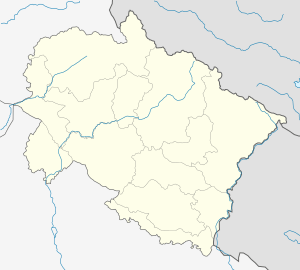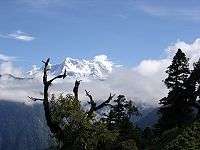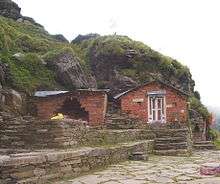Tungnath
Tungnath is one of the highest Shiva temples in the world[1] and is the highest of the five Panch Kedar temples located in the mountain range of Tunganath in Rudraprayag district, in the Indian state of Uttarakhand. The Tunganath (literal meaning: Lord of the peaks) mountains form the Mandakini and Alaknanda river valleys. It is located at an altitude of 3,680 m (12,073 ft), and just below the peak of Chandrashila.[2] and is the third (Tritiya Kedar) in the pecking order of the Panch Kedars. It has a rich legend linked to the Pandavas, heroes of the Mahabharata epic.[3][4]
| Tungnath | |
|---|---|
 | |
| Religion | |
| Affiliation | Hinduism |
| District | Rudraprayag |
| Location | |
| State | Uttarakhand |
| Country | India |
 Location in Uttarakhand | |
| Geographic coordinates | 30°29′22″N 79°12′55″E |
| Architecture | |
| Type | North Indian architecture |
| Completed | Unknown |
| Elevation | 3,680 m (12,073 ft) |
Legend
According to Hindu mythology, Lord Shiva and his consort, Parvati both reside in the Himalayas: Lord Shiva resides at Mount Kailash. Parvati is also called Shail Putri, which means 'daughter of hills'.[3]
The Tunganath is indelibly linked to the origin of the Panch Kedar temples built by the Pandavas. The legend states that sage Vyas Rishi advised the Pandavas that since they were culpable of slaying their own relatives (Kauravas, their cousins) during the Kurukshetra war, their act could be pardoned only by Lord Shiva.[5] Consequently, the Pandavas went in search of Shiva who was avoiding them since he was convinced of the guilt of Pandavas. In order to keep away from them, Shiva took the form of a bull and went into hiding in an underground safe haven at Guptakashi, where Pandavas chased him. Later, Shiva's body in the form of bull's body parts rematerialized at five different locations that represent the Panch Kedar. The Pandavas built temples at each of these locations to worship and venerate Lord Shiva, seeking his pardon and blessings. Each temple is identified with a part of the bull or Shiva's body; Tungnath is identified as the place where the bahu (hands) were seen; hump was seen at Kedarnath; head appeared at Rudranath; his navel and stomach surfaced at Madhyamaheshwar; and his jata (hair or locks) at Kalpeshwar.[4][6][7][8]
Legend also states that Lord Rama, the central character of Ramayana, meditated at the Chandrashila peak which is close to Tungnath, in India. It is also said that Ravana performed penance to Shiva, the lord of the peaks, when he resided here.[4]
Worship
The priest at this temple is a local Brahmin from Makku village, unlike the other Kedar temples where the priests are from South India, a tradition set by the eighth century Hindu seer Sankaracharya. It is also said that the Maithani Brahmins officiate as priests at this temple. During the winter season, the temple is closed and the symbolic image of the deity and the temple priests are moved to Makkumath, which is 29km from here. It is near Duggalbitha 10 km (6 mi) before Chopta towards Ukhimath.[9][10][11]
Geography

Tungnath is at the top of the ridge dividing the waters of the Mandakini River (raising from Kedarnath) from those of the Alaknanda River (raising above Badrinath). The Tungnath peak on this ridge is the source of three springs, which form the Akashkamini River. The temple lies about 2 km (1.2 mi) below the Chandrashila Peak (4,000 m (13,123 ft)). The road to Chopta is just below this ridge and hence provides the shortest bridle approach path for trekking to the temple from Chopta, over a short distance of about 5 km (3.1 mi). From the top of the Chandrashila peak, picturesque views of the Himalayan range comprising snow peaks of Nanda Devi, Panch Chuli, Banderpoonch, Kedarnath, Chaukhamba and Neelkanth on one side, and the Garhwal valley on the opposite side could be witnessed. The valley between Chopta and Tunganath temple has wooded hills with rich alpine meadows with rhododendron coppices and also agricultural fields. The rhododendrons, when they are in full bloom during March, display dazzling colours ranging from crimson to pink. A high-altitude botanical station of the Garhwal University is located here. Nearing the top of the temple, there is a forest resthouse at Dugalibitta, just opposite to the Kedarnath range of hills. The Kedaranth Wild Life Sanctuary, also called the Kedarnath Musk Deer Sanctuary, set up in 1972 to preserve the endangered musk deer, which lies in the region, also has a musk deer breeding centre at Kharchula Kharak near Chopta.[12][13][14][15]
Climate
Climate of Tungnath is generally cool throughout the year. Summers are pleasant with average temperature hovering around 16 degrees Celsius during the day time. Winters are very chilly and temperature drops below the freezing point very frequently. The best time to visit the temple is from April to September. Due to heavy snowfall, Tungnath temple remains closed for around 6 months during winter.[16]
Trekking and access
The 5 km (3.1 mi) trek starts from Chopta (9,600 ft (2,926 m)), the nearest place on the NH 58. Chopta is 63 km (39 mi) from Rudraprayag towards Karnaprayag and is reached from Rishikesh via Devprayag, Srinagar and Rudraprayag.
Of all the Panch Kedar trek routes, the route to Tungnath is the shortest: only 5 km (3.1 mi) from Chopta (on the Ukhimath Gopeshwar road) that can be covered in approximately 4–5 hours (depending on the trekker's physical ability). Trek is a steep climb (9,600–11,350 ft (2,926–3,459 m)), the trek path is stone paved with benches provided en route at intervals.[12] Generally, the pilgrimage to Tunganath is undertaken as part of the Panch Kedar trekking covering all five temples over a 170 km (105.6 mi) route (road cum trek length) starting from Rishikesh in the order of: Kedarnath, Tungnath, Rudranath, Madhyamaheswar and Kalpeshwar. The few pilgrims who undertake this trekking pilgrimage to the shrine do so in summer months (end April or early May to October) as the temple remains snow bound and unapproachable. During this period even Chopta, the nearest road head remains deserted. But it is said that few adepts come to the area during the winter avoiding the pilgrims. The steep climb to Chandarshila is for 2 km (1.2 mi).[3][4][12]
The nearest airport is Jolly Grant, Dehradun (258 km (160 mi)). The nearest railway station is at Rishikesh (241 km (150 mi)).[17]
Gallery


References
- Ayandrali Dutta (5 February 2018). "Tungnath: The Highest Shiva Temple". Magazine | RoundGlass. Retrieved 14 December 2019.
- "HT".
- "Chopta, Tungnath and Chandrashila". euttaranchal. Retrieved 11 July 2009.
- Rajmani Tigunai (2002). At the Eleventh Hour. Shrine of Tungnath. Himalayan Institute Press. pp. 93–94. ISBN 9780893892128. Retrieved 15 July 2009.
- Ramanan, Vrinda and J. (23 November 2017). "Trekking to Tunganath, the third of the Panch Kedar". The Hindu. ISSN 0971-751X. Retrieved 14 December 2019.
- "Tungnath". Retrieved 11 July 2009.
- "Panch Kedar Yatra". Archived from the original on 24 May 2011. Retrieved 5 July 2009.
- Kapoor. A. K.; Satwanti Kapoor. Ecology and man in the Himalayas. M.D. Publications Pvt. Ltd. p. 250. ISBN 9788185880167.
- "Pancha Kedar". Archived from the original on 31 August 2009. Retrieved 15 July 2009.
- "Panch Kedar Yatra". Archived from the original on 24 May 2011. Retrieved 15 July 2009.
- Jha, Makhan (1998). India and Nepal. Sacred Complex in Garhwal Himalayas. M.D. Publications Pvt. Ltd. p. 143. ISBN 9788175330818.
- Roma Bradnock (2000). Indian Himalaya handbook. The Panch Kedars. Footprint Travel Guides. pp. 114–115. ISBN 9781900949798.
- Vishwambhar Prasad Sati; Kamlesh Kumar (2004). Uttaranchal: Dilemma Of Plenties And Scarcities. Kedarnath. Mittal Publications. pp. 202–204. ISBN 9788170998983. Retrieved 15 July 2009.
- "Panch Kedar-Tungnath". Retrieved 17 October 2008.
- Bill Aitken (2003). Footloose in the Himalaya. Chapter 15:The best little Trek. Orient Blackswan. pp. 134–137. ISBN 9788178240527.
- "Tungnath | Uttarakhand Tourism Development Board". uttarakhandtourism.gov.in. Retrieved 15 August 2018.
- "Panch Kedar: Rudranath". Shri Badrinath -Shri Kedarnath Temple Committee. 2006. Archived from the original on 21 July 2011. Retrieved 16 July 2009.



